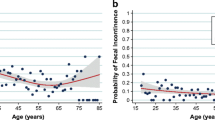Abstract
Since 1958, the National Disease and Therapeutic Index (NDTI) has provided annual statistics summarizing the frequency physicians throughout the United States are visited for different disease conditions. In our present study, these data were used to examine the epidemiology of constipation. Since NDTI statistics are available for a longer time period than other U.S. statistics, they might confirm or disprove the relevance of recent environmental changes on the occurrence of this disorder. The average number of physician visits for constipation in the United States was 2.5 million per year, corresponding to a prevalence of 1.2%. The largest number of these patients (31%) was seen by general and family practitioners, followed in declining order by internists (20%) and pediatricians (15%). Only 4% of all these patients was seen by gastroenterologists. Eighty-five percent of these patients received a prescription for medication, with laxatives and cathartics being the most frequently prescribed drugs. Among physician visits for constipation, female prevalence was 1.6% compared with 0.8% for males (P<0.001). In both sexes, there was a significant age-related increase in the rate of physician visits, with the steepest rise from 1.3% to 4.1% occurring between the age groups 60–64 and over 65. From 1958 to 1986, the rate of all physician visits for constipation remained unchanged. However, during this time period, there was a twofold rise in physician visits for those patients ages 0–9 years, while a smooth decline occurred in all of the older age groups. This information, which was derived directly from physicians, confirmed the epidemiology of constipation previously obtained through household interviews of the National Health Interview Survey (NHIS). The prevalence of constipation found in the present study lies in the same order of magnitude as the 2% found in the NHIS. The twofold higher prevalence infernales and the marked rise after the age of 65 are consistent with the epidemiologic pattern outlined by the NHIS data. Constipation appears to represent a permanent medical condition in the adult U.S. population, which has not changed in the past 28 years. Modern life-style, which should be associated with more sedentary occupations and consumption of processed food, did not appear to affect the occurrence of constipation. Instead, modern life-style may be protective and may have reduced the frequency of constipation.
Similar content being viewed by others
References
Sonnenberg A, Koch TR: Epidemiology of constipation in the United States. Dis Colon Rectum 32:1–8, 1989
National Center for Health Statistics, Gleeson GA: Interviewing methods in the Health Interview Survey. Vital and Health Statistics. Series 2, No. 48. DHEW Pub. No. (HSM) 72-1048. Health Services and Mental Health Administration. Washington, DC, U.S. Government Printing Office, April 1972
Burkitt DP, Walker ARP, Painter NS: Effect of dietary fibre on stools and transit times, and its role in the causation of disease. Lancet 2:1408–1412, 1972
Sonnenberg A: Changes in physician visits for gastric and duodenal ulcer in the United States during 1958–1984 as shown by National Disease and Therapeutic Index (NDTI). Dig Dis Sci 32:1–7, 1987
U.S. Bureau of the Census: Current Population Reports, Series P-25, No. 212, 519, 643, 721, 870, 917, 949, 985. Washington, DC, U.S. Government Printing Office, 1960–1985
. Bureau of the Census Current Population Reports, series P-25, No. 304, 460, 957. Washington, DC, U.S. Government Printing Office, 1965–1984
Lew EA, Singer RB: Interpretation of mortality and survival data.In: Medical Risks: Patterns of Mortality and Survival. RB Singer (ed). Lexington, Massachusetts, Lexington Books, 1976, pp 23–32
Zar JH: Biostatistical Analysis, 2nd ed. Englewood Cliffs, New Jersey, Prentice-Hall, 1984, pp 126–131
Kahn HA: An Introduction to Epidemiologic Methods. New York, Oxford University Press, 1983, pp 48–52
Sonnenberg A: Mortality from Crohn's disease and ulcerative colitis in England-Wales and the United States from 1950 to 1983. Dis Colon Rectum 29:625–629, 1986
Bentley JRF: Constipation in infants and children. Gut 12:85–90, 1971
Clayden GS: Constipation and soiling in childhood. Br Med J 1:515–517, 1976
Bentley FRF: Fecal soiling and anal achalasia. Arch Dis Child 53:185–186, 1978
Gryboski J, Walker WA: Constipation.In Gastrointestinal Problems in the Infant, 2nd ed. J Gryboski, WA Walker (eds). Philadelphia, WB Saunders, 1983, pp 7–9
Author information
Authors and Affiliations
Additional information
This work was supported by grant So 172/1-1 from the Deutsche Forschungsgemeinschaft.
Rights and permissions
About this article
Cite this article
Sonnenberg, A., Koch, T.R. Physician visits in the United States for constipation: 1958 to 1986. Digest Dis Sci 34, 606–611 (1989). https://doi.org/10.1007/BF01536339
Received:
Revised:
Accepted:
Issue Date:
DOI: https://doi.org/10.1007/BF01536339




